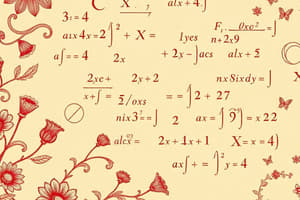Podcast
Questions and Answers
What is the highest power of the variable in a linear equation?
What is the highest power of the variable in a linear equation?
- 3
- 2
- 0
- 1 (correct)
What is the general form of a linear equation with two variables?
What is the general form of a linear equation with two variables?
- ax * by = c
- ax - by = c
- ax / by = c
- ax + by = c (correct)
What is the property of linear equations that states ax + by is also a solution?
What is the property of linear equations that states ax + by is also a solution?
- Linearity (correct)
- Scalability
- Additivity
- Homogeneity
What is the graph of a linear equation?
What is the graph of a linear equation?
What is the slope-intercept form of a linear equation?
What is the slope-intercept form of a linear equation?
What method involves adding or subtracting the same value to both sides of the equation?
What method involves adding or subtracting the same value to both sides of the equation?
What is an application of linear equations in real-world scenarios?
What is an application of linear equations in real-world scenarios?
What is a type of linear equation with one variable?
What is a type of linear equation with one variable?
Flashcards are hidden until you start studying
Study Notes
Definition and Terminology
- A linear equation is an equation in which the highest power of the variable(s) is 1.
- It can be written in the form: ax + by = c, where a, b, and c are constants, and x and y are variables.
- The coefficients of the variables (a and b) can be any real numbers, including fractions and decimals.
Types of Linear Equations
- Simple Linear Equations: Equations with one variable, e.g., 2x = 5.
- Linear Equations with Two Variables: Equations with two variables, e.g., 2x + 3y = 7.
Properties of Linear Equations
- Linearity: If x and y are solutions to a linear equation, then ax + by is also a solution, where a and b are constants.
- Homogeneity: If x is a solution to a linear equation, then kx is also a solution, where k is a constant.
Graphing Linear Equations
- The graph of a linear equation is a straight line.
- The slope-intercept form of a linear equation is y = mx + b, where m is the slope and b is the y-intercept.
- The standard form of a linear equation is Ax + By = C, where A, B, and C are integers.
Solving Linear Equations
- Addition and Subtraction Method: Add or subtract the same value to both sides of the equation to isolate the variable.
- Multiplication and Division Method: Multiply or divide both sides of the equation by the same non-zero value to isolate the variable.
- Graphical Method: Find the point of intersection of two linear equations to solve a system of linear equations.
Applications of Linear Equations
- Real-World Problems: Linear equations can be used to model real-world scenarios, such as calculating the cost of goods, the area of a rectangle, and the slope of a ramp.
- Science and Engineering: Linear equations are used to describe the motion of objects, the growth of populations, and the behavior of electrical circuits.
Linear Equations
- A linear equation is an equation in which the highest power of the variable(s) is 1 and can be written in the form: ax + by = c.
- The coefficients of the variables (a and b) can be any real numbers, including fractions and decimals.
Types of Linear Equations
- Simple linear equations have one variable, e.g., 2x = 5.
- Linear equations with two variables have two variables, e.g., 2x + 3y = 7.
Properties of Linear Equations
- Linearity: if x and y are solutions to a linear equation, then ax + by is also a solution, where a and b are constants.
- Homogeneity: if x is a solution to a linear equation, then kx is also a solution, where k is a constant.
Graphing Linear Equations
- The graph of a linear equation is a straight line.
- The slope-intercept form of a linear equation is y = mx + b, where m is the slope and b is the y-intercept.
- The standard form of a linear equation is Ax + By = C, where A, B, and C are integers.
Solving Linear Equations
- The addition and subtraction method involves adding or subtracting the same value to both sides of the equation to isolate the variable.
- The multiplication and division method involves multiplying or dividing both sides of the equation by the same non-zero value to isolate the variable.
- The graphical method involves finding the point of intersection of two linear equations to solve a system of linear equations.
Applications of Linear Equations
- Linear equations can be used to model real-world scenarios, such as calculating the cost of goods, the area of a rectangle, and the slope of a ramp.
- Linear equations are used in science and engineering to describe the motion of objects, the growth of populations, and the behavior of electrical circuits.
Studying That Suits You
Use AI to generate personalized quizzes and flashcards to suit your learning preferences.




